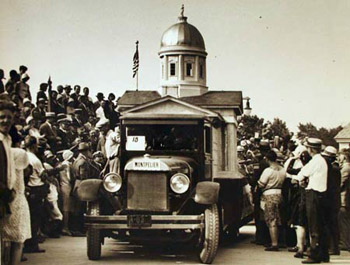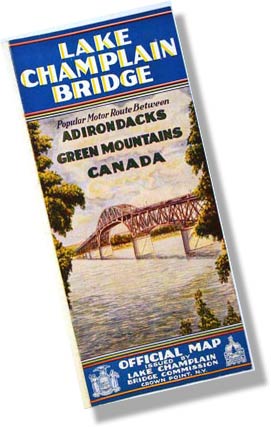

Hampshire Library Digital Collections Initiative.
A Strategic Location
When the Lake Champlain Bridge Commission searched for a location to place the first highway bridge across Lake Champlain, it chose a place where humans had been crossing the lake for at least 9,000 years. The distance between Chimney Point, Vermont, and Crown Point, New York, (one of the shortest along the 120-mile long lake) offered desirable bedrock on which to build a bridge. Long ago, Native Americans camped along these shores. They were followed by the French, who built a fort at Chimney Point in 1731 and moved across the lake three years later to create Fort St. Frédéric in Crown Point. Desire to control this narrow passage on Lake Champlain, strategically important militarily, led the British to drive the French from the valley in 1759 and build their own fort at Crown Point, only to lose it in 1773, when a chimney fire led to an explosion of the ammunition magazine. The British eventually abandoned it three years later. Before the end of that century, ferries, powered by sail, began crossing the lake on a route where a highway bridge would someday rise above.

Photo courtesy of Fay,
Spofford & Thorndike
Bridging Lake Champlain
As automobile use grew in the first part of the 20th century, Lake Champlain was viewed as a barrier to tourism and growth. To better accommodate travel, the states of New York and Vermont joined together to form the Lake Champlain Bridge Commission in 1927. This Commission studied numerous locations for a bridge crossing and oversaw the construction and operation of the bridge until 1987.The bridge was financed by bonds, paid back by tolls collected from vehicles crossing the bridge.

Photo courtesy Vermont State Archives.
It took only 15 months to build the bridge at a cost of $967,800. As designed by Charles M. Spofford, of the Boston firm Fay, Spofford & Thorndike, the main arch of the 2,186-foot long bridge had to be built high enough to allow steamboats with tall smokestacks to pass safely underneath. The 28-foot wide bridge had sidewalks when first built, and people crossing on foot could view a plaque in the center marking the boundary between the two states.
Amazingly for this relatively rural area, 40,000 people came to the August 26, 1929 opening day ceremony, which was described as the “event of the century” for the Champlain Valley. Communities and individuals from all around the lake and as far as 50 miles away participated in the celebration parade of floats, marching bands, automobiles and a boat flotilla. The connection between the states, so evident on opening day, would continue to grow over the decades, once this convenient crossing for motorized vehicles was established.

Photo courtesy of Vermont State Archives.
A Cultural and Engineering Landmark
While the aesthetically pleasing design of the 1929 Lake Champlain Bridge inspired affection as it became a cultural icon of the region, its engineering brilliance contributed to bridge building techniques used throughout the 20th century. Spofford faced many design challenges at this site. The bedrock was too deep to provide good support for an arch or suspension type bridge. The 2,000-plus foot length of the crossing and height requirements for marine traffic also would influence the design.
Spofford’s approach to these design challenges was to refine the “continuous beam” or “truss” technology, already popular with railroad engineers, and which had the advantages of cost savings and more efficiently distributing stresses. The Lake Champlain Bridge was the first long highway bridge to use that continuous truss technology. Spofford advanced this technology by using a cantilever system to create a graceful transition between the approach spans, with low curving deck trusses, and the arching through truss channel span. This design not only solved the problem of a visually awkward transition where the deck truss and the through truss meet, it also reduced construction costs.
This innovative design was described by engineers as an “elegant solution” that resulted in a strikingly beautiful bridge rising over Lake Champlain with New York’s Adirondack and Vermont’s Green Mountains in the distance. It could be seen from miles away as people drove toward the crossing. Its light-colored, arching steel frame was a welcome presence, even on a cloudy day. While the 1929 Lake Champlain Bridge design fit beautifully into its setting, it also had to be threaded among historic resources of national significance on both sides of and beneath the lake. The bridge touched down within a few feet of the ruins of Fort St. Frédéric on the New York side and was very close to the historic Chimney Point tavern in Vermont.
Serving the Region for 80 Years

When the bridge opened in 1929, it had a $1 toll, which was a considerable cost at the time. In its early years, most of the local residents did not own cars and considered the toll expensive, especially during the Great Depression. But, from opening day, tourists and truckers took advantage of the bridge’s convenience, allowing the Bridge Commission to pay off on schedule the bonds used to finance bridge construction. After World War II, local use began to rise and the tolls decreased once the bonds were retired. By the 1970s, commuters could cross the lake for as little as six cents a trip by using 100-coupon booklets. A regional economy dependent on the bridge evolved as people traveled between the states for work, shopping, medical services, excursions and family visits.

Brochure courtesy of Vermont State Archives.
The Lake Champlain Bridge Commission operated and maintained the bridge until 1987. In that year, the Rouses Point Bridge at the northern end of Lake Champlain, also operated by the Bridge Commission, needed replacement. This capital expense, along with needed repairs to the Lake Champlain Bridge, was too much for the Commission to shoulder, and led to
the dissolution of the Lake Champlain Bridge Commission. New York State and Vermont agreed to assume joint ownership of both bridges, assigning management responsibility for the Rouses Point Bridge to Vermont and the Lake Champlain Bri
dge to New York. Under state management, federal funds were used for bridge maintenance so tolls could no longer be collected.
Despite ongoing maintenance and periodic large scale repairs, the Lake Champlain Bridge continued to deteriorate. Age and damage from salt and heavy trucks took a visible toll. But it was damage that couldn’t be seen easily that led to the bridge’s demise. In early October 2009, Lake Champlain’s water level dropped. Engineers inspecting major repair work under way that summer noticed significant deterioration of the bridge piers near the water line. Concerned about safety, transportation officials authorized structural analysis and ordered underwater inspections. As a result of the structural analysis, the bridge was closed the afternoon of October 16, 2009. With limited options to cross the lake, people faced an 85-mile land detour. A state of emergency was declared by the states of New York and Vermont.
Shortly after the bridge was closed, the underwater inspections confirmed the decision to close the bridge, revealing serious cracks in the bridge piers. These cracks weakened the concrete and compromised the safety of the bridge. Spofford used iron ore tailings from local mines as aggregate in the concrete. This made exceptionally strong concrete, most likely leading Spofford to conclude that steel reinforcement was unnecessary. Also, in 1929 and even today, there are very few lake bridges, so the need for armor to protect the piers from lake ice was not fully understood.
Engineering evaluation showed that while short-term and long-term rehabilitation or replacement of the piers was technically possible, it could not be guaranteed as a long-term solution. Furthermore, the fragility of the bridge condition would have resulted in unacceptable danger to construction workers, and led to a decision to demolish rather than rehabilitate the bridge. The 1929 Lake Champlain Bridge was demolished by implosion on December 28, 2009.
Responding to Loss
Many residents were deeply saddened and some wept the day the bridge came down. People who had grown up with the bridge couldn’t imagine a time without it. At night, the view across the lake from the Village of Port Henry was now of darkness rather than a row of twinkling lights from the bridge. Without the bridge, people struggled with four-hour commutes, separation from family, friends and medical services. At public meetings, they urged transportation officials to rebuild the bridge at its original location and to provide a temporary ferry to reconnect the corridor upon which their lives depended.

Through unprecedented collaboration of government officials at every level in New York, Vermont and the federal government, the work of restoring normalcy to those affected proceeded at lightning speed. Vermont and New York quickly decided to demolish the bridge, to construct temporary ferry facilities, and to build a new bridge in the same location. Through an extensive public outreach process, a consensus emerged over a long weekend in mid-December 2009 on a new bridge design that was supported by a majority. Despite bitter winter weather and high lake winds, construction crews worked 20 hours a day, seven days a week to remove the demolished bridge and establish a new ferry crossing. The new temporary ferry service between Chimney Point and Crown Point opened on February 1, 2010.
The new Lake Champlain Bridge is a different design from the 1929 bridge. Yet, the arching form of the new design is reminiscent of the old bridge and responds to the scenic quality of the area in a similar way. Many people preferred this design because it evokes the elegance of the original bridge.
Remembering the 1929 Lake Champlain Bridge

“I think that we all have an appreciation for beauty. This was a beautiful structure, whether you understood that it was the first in the country for such and such kind of engineering and technology, you understood simply by looking at it that it was beautiful and that it was special. If you used it every day to go to work or to take someone to the hospital or to visit relatives on the other side of the lake, you didn’t simply just pass over it; you had to experience it both while you were crossing it and to be up there high looking out across the lake and the mountains in either direction. But you also had to get to it. And no matter whether you were coming there from Vermont or New York, you had to wind your way to it and you would glimpse it here and you would glimpse it there and so it was something you couldn’t ignore. It was just part of your experience of crossing the lake that was really special.
Often time bridges are something that we don’t actually see. We cross on top of them, they’re underneath us. A lot of them are in fairly short spans and it’s over very quickly. But the Lake Champlain Bridge might take five minutes to fully experience from seeing for the first time to leaving it behind in your rearview mirror. Between the beauty, the familiarity, the way you experience it, people just took it into themselves in a way. That’s really unusual.”
Steven Engelhart
Adirondack Architectural Heritage
